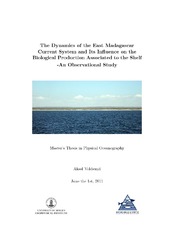| dc.description.abstract | The dynamics of the East Madagascar Current (EMC) system, and its influence on the biological production associated to the shelf, is studied by using cruise-data collected onboard the Norwegian R/V. Dr. Fridtjof Nansen between August and October, 2008. The South Equatorial Current (SEC) hits the coast of Madagascar at 19°S, bifurcating into a northwards and southwards directed branch of the EMC. The southwards directed branch behaves like a strong (up to 150 cms−1) western boundary current, with a volume transport of ~26 Sv at 25°S. The volume transport was calculated using geostrophic current profiles adjusted with ADCP measurements at 176 meters depth. At the south-eastern corner of the island, some of the EMC continues south-westwards, and some is retroflected north-eastwards. Cyclonic eddies are expected to be generated inshore of the EMC, while the anticyclonic eddies seem to the shed off the retroflected part of the current. The currents of the northwards directed branch of the EMC are weaker (up to 60 cms−1) just north of the bifurcation. The volume transport increases between 13.5°S and 12°S. This could be explained by another incoming branch of the SEC. The north-westwards directed volume transport north of the island (12°S) is ~62 Sv. The wind distribution seems to be the most important factor explaining the current system at the eastern coast. Wind and current driven upwelling seems to be the most important physical factor stimulating the biological production of the southern and south-eastern coasts. The south-eastern corner of the island could be considered as a biological hot-spot, where a divergent current field contributes to the upwelling. Discharge of nutrient rich water from rivers seems to contribute to the production at the north-eastern coast. The width of the shelf has also turned out to be an important factor. | en_US |
